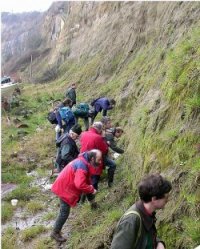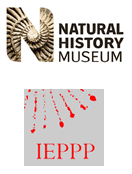

All images are copyright to the Natural History Museum, London
Methods

The rationale for this study is that a major scientific UK establishment (the Natural History Museum) and a key player in the UK's Biodiversity policy, which is itself a model for wider global uptake, is embarked upon a new set of interactions ('facilitation') with new actors (volunteer naturalists) in a revised policy discourse and framework (privileging 'participation' and a 'dynamic approach' to conservation). The novelty of this situation presents certain questions which frame the study and which are particularly amenable to investigation through a multi-sited ethnographic approach (Marcus 1995).
These questions include:
- How does the participation of volunteer naturalists take place in practice in the UK BAP context?
- What defines the boundaries and intersections between volunteer naturalist knowledges, and professional conservation and 'facilitator' knowledges about biodiversity?
- What defines expertise in each of the (overlapping) domains and how does expertise in the different domains differ?
- What are the implicaitons of these differences and boundaries for the design and implementation of 'inclusionary' policy?
- What varying forms of scientific practice and record-keeping exist in the different communities of naturalists and professional conservationists?
- Are there differences of 'meaning' attached to 'knowing' plant and animal species? What elements (social, cultural, ontological and epistemological) contribute to the development and transmission of such meanings?
- What expectations of 'ownership' of data are sustained in different naturalist/professional conservation communities?
- What expectations do individuals from different domains entertain regarding data contributions to biodiversity policy?
- How do different communities gain satisfaction/reimbursement from the effort and time they invest in producing knowledge about the natural world?
- What role does data validation and standardisation play both within amateur society/recording and biodiversity policy circles?
- In which networks are different communities included?
- From which networks and practices are communities excluded?
- Do different communities trust and communicate with each other?
- What changes in the volunteer naturalist, science and policy domains are occurring as a result of the new types of volunteer 'enrolment' that the Natural History Museum is engaged with?
- How can sociological/anthropological understandings of the events and initiatives spearheaded by the Natural History Museum help illuminate wider debates about: a) biodiversity conservation - locally, nationally and globally?; b) debates about participation in policy-making; c) debates about the relationship between science, policy and society?
An ethnographic methodology has been chosen for specific reasons:
- The iterative nature of the method, allowing interactive work to take place and relationships to be built between researchers and those being researched.
- The possibility of being a participant-observer of 'science-in-action' (Latour 1985) - for example, doing field work with volunteer naturalists, observing and taking part in policy work at policy workshops, working with facilitators within the Natural History Museum.
- The possibility of tracing the way that locally constituted knowledges and meanings 'travel' across social and cultural boundaries - for example, how records, and meanings attached to them, change from an amateur naturalist setting to a policy setting.
- The possibility of creating a more permeable boundary between scholarship (in sociology/anthropology of science) and social action within amateur/facilitator/policy /scientific worlds.
- The possibility of mapping possible points of innovation or action (Rapp 1999).
After initial familiarisation with the policy field, literature, relevant actors and locales which took place in the first four months of the project, ethnographic field work has and will continue to be undertaken by two researchers (Rebecca Ellis and Claire Waterton). This occurs in three (sometimes overlapping) domains: biodiversity policy; amateur / volunteer naturalist; the 'facilitator' domain within the Natural History Museum. Fieldwork began in November 2002 and will be continuous until September 2004. In each domain it involves: one-to-one interviews; participant observation in meetings, fieldwork and data-gathering exercises; and importantly, representation of the ethnographic work and its evolving interpretation to the different communities through seminars, meetings and conferences. Our role as multi-sited ethnographers exposes us to a range of perceptions of the biodiversity amateur / volunteer and professional worlds within which we are moving. We realise that this potentially places us in an important position from which to triangulate information between all the parties concerned. We expect during the following year of research, to find the most suitable and frutiful ways of sharing our observations with the range of actors involved in the research project.

| Update on the Research | Related Information | Contact |
